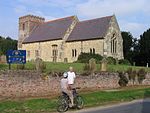Bainton railway station
Disused railway stations in the East Riding of YorkshireFormer North Eastern Railway (UK) stationsPages with no open date in Infobox stationRailway stations in Great Britain closed in 1954Railway stations in Great Britain opened in 1890 ... and 2 more
Use British English from April 2017Yorkshire and the Humber railway station stubs

Bainton railway station was a station on the Selby to Driffield Line. It opened on 1 May 1890 and served the village of Bainton. It closed on 20 September 1954.
Excerpt from the Wikipedia article Bainton railway station (License: CC BY-SA 3.0, Authors, Images).Bainton railway station
Station Road,
Geographical coordinates (GPS) Address Nearby Places Show on map
Geographical coordinates (GPS)
| Latitude | Longitude |
|---|---|
| N 53.945967 ° | E -0.52634 ° |
Address
Station Road
Station Road
YO25 9EQ , Middleton
England, United Kingdom
Open on Google Maps











